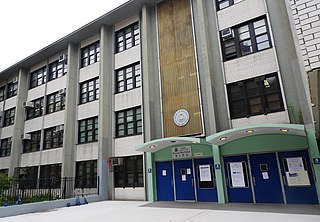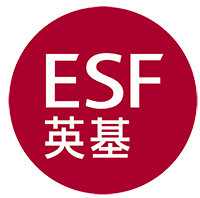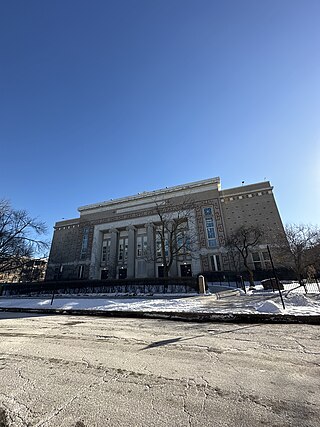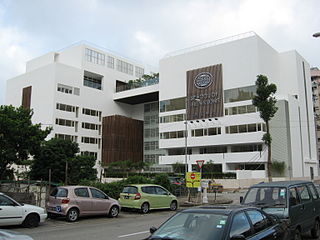
PS 184M Shuang Wen School, a public school in New York City also known as PS 184, is a Dual Language elementary and middle school located in Lower Manhattan. The school teaches students from Pre-Kindergarten to 8th grade. It is a part of the New York City Department of Education and located in Manhattan District 1 which includes the Lower East Side and East Village. A major $1.7 million renovation of the school playground and soccer field was completed in 2019 by the Trust for Public Land and DEP. In the elementary school, the school teaches in Traditional Chinese and utilizes the zhuyin phonetic system popular in Taiwan. During the typical school day, one day is taught in English and other day is in Mandarin. As a Dual Language school, classes in both languages are a mandatory part of the curriculum.

Language immersion, or simply immersion, is a technique used in bilingual language education in which two languages are used for instruction in a variety of topics, including maths, science, or social studies. The languages used for instruction are referred to as the L1 and the L2 for each student, with L1 being the student's native language and L2 being the second language to be acquired through immersion programs and techniques. There are different types of language immersion that depend on the age of the students, the classtime spent in L2, the subjects that are taught, and the level of participation by the speakers of L1.
The educational system in Taiwan is the responsibility of the Ministry of Education. The system produces pupils with some of the highest test scores in the world, especially in mathematics and science. Former president Ma Ying-jeou announced in January 2011 that the government would begin the phased implementation of a twelve-year compulsory education program by 2014.

The English Schools Foundation (ESF) is an organisation that runs 22 international schools in Hong Kong. It is Hong Kong's largest English-medium organisation of international schools. It was founded in 1967 with the passage of the English Schools Foundation Ordinance.

Edmonton Public Schools is the largest public school division in Edmonton, the second largest in Alberta, and the sixth largest in Canada. The division offers a variety of alternative and special needs programs, and many are offered in multiple locations to improve accessibility for students. As a public school division, Edmonton Public Schools accepts all students who meet the age and residency requirements set out in provincial legislation.
Education in the Philippines is compulsory at the basic education level, composed of kindergarten, elementary school, junior high school, and senior high school. The educational system is managed by three government agencies by level of education: the Department of Education (DepEd) for basic education; the Commission on Higher Education (CHED) for higher education; and the Technical Education and Skills Development Authority (TESDA) for technical and vocational education. Public education is funded by the national government.
Education in Alberta is provided mainly through funding from the provincial government. The earliest form of formal education in Alberta is usually preschool which is not mandatory and is then followed by the partially-mandatory kindergarten to Grade 12. This is managed by Alberta Education which has divided the province into 379 school authorities. Higher education in the province is managed by Alberta Advanced Education.
Dual language is a form of education in which students are taught literacy and content in two languages. Most dual language programs in the United States teach in English and Spanish, but programs increasingly use a partner language other than Spanish, such as Arabic, Chinese, French, Hawaiian, Japanese, or Korean. Dual language programs use the partner language for at least half of the instructional day in the elementary years.

Inter-American Magnet School is a K-8 magnet school in Lake View, Chicago, Illinois. The oldest two-way bilingual school in the Midwestern United States, it is a part of Chicago Public Schools (CPS).

The School of the Nations is a Baháʼí-inspired school located in Taipa, Macau, owned by the Badi Foundation.

National Nanke International Experimental High School, situated in the Southern Taiwan Science Park (STSP), is a public, co-educational school serving Grades 1 -12. NNKIEH was founded in 2006 in order to ensure a good academic environment for the children of both local Science Park employees as well as foreign high-tech professionals. The school is multi-cultural. Three of the departments are for local Chinese students and adopt the Taiwanese (R.O.C.) national curriculum, while the Bilingual Department serves students in the English-speaking community who seek an American college-preparatory education.

Beijing City International School (BCIS) is an independent co-educational not-for-profit day school offering an international curriculum for toddler to twelfth grade students.
Cupertino Language Immersion Program (CLIP) is an alternative K-8 education program located at John Muir Elementary School (K-5) and Joaquin Miller Middle School (6-8) in the Cupertino Union School District (CUSD). CLIP is the oldest public Mandarin Immersion program in California and the second oldest in the country.
Pan-Asia International School, or PAIS, is an International School located in Prawet District, Bangkok, Thailand, and a member of the International Schools Association of Thailand (ISAT). Established in 2004, PAIS provides international education built upon American standards with a strong emphasis on eastern culture to over 470 students representing more than 41 nations.
Practices in language education vary significantly by region. Firstly, the languages being learned differ; in the United States, Spanish is the most popular language to be learned, whereas the most popular languages to be learned in Australia are German, French, Italian and Mandarin Chinese. Also, teaching methods tend to differ by region. Language immersion is popular in some European countries, and not used very much in the United States.

Miami-Dade County Public Schools (M-DCPS) is the public school district serving Miami-Dade County in the U.S. state of Florida. Founded in 1885, it is the largest school district in Florida, the largest in the Southeastern United States, and the third-largest in the United States with a student enrollment of 356,589 as of August 30, 2021.

Mandarin Immersion Magnet School (MIMS), formerly Mandarin Chinese Language Immersion Magnet School (MCLIMS), is a magnet school in Houston, Texas, United States. It was established in 2012 and is part of the Houston Independent School District (HISD). The school's current campus in the St. George Place area of Houston opened in August 2016; it was previously located in the former Maud Gordon Elementary School in Bellaire, Texas.
M.E. LaZerte High School is a high school in Edmonton, Alberta, Canada in the north eastern Kilkenny neighbourhood. It is part of Edmonton Public Schools. The school's team name is the Voyageurs, which is also what they call the student body.
In bilingual education, students are taught content areas like math, science, and history in two languages. Numerous countries or regions have implemented different forms of bilingual education.










